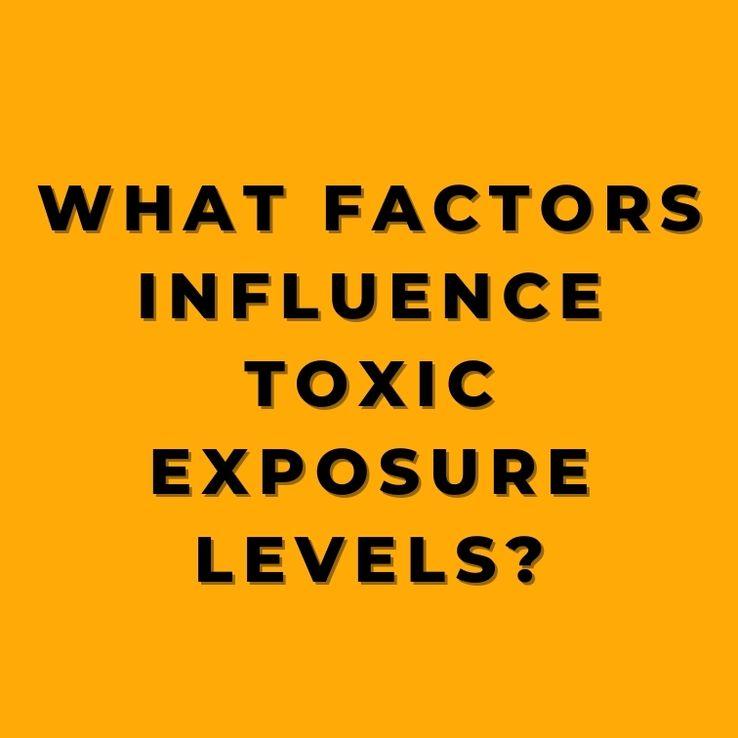Knowing the factors that influence toxic exposure levels can help workers and employers take the necessary precautions to protect themselves and their colleagues from harm. Toxic exposure in the workplace is a serious issue that can have severe consequences for workers and their employers. Additionally, many more workers suffer from illnesses and injuries that can be caused by toxic exposure. It’s crucial for workers and employers to understand the factors that influence toxic exposure levels so that they can take the necessary precautions to protect themselves and their colleagues from harm. To highlight these dangers, allow me to reference a few statistics. For example, according to the U.S. Bureau of Labor Statistics (BLS), in 2017, 41 U.S. workers died on the job after a single episode of inhaling chemicals and chemical products. The range of fatalities per year from 2011 to 2017 was from 33 to 55 fatal injuries each year, with a total of 297 fatalities across the 7-year time period.
Knowing the factors that influence toxic exposure levels is crucial for protecting workers and employers from harm. These factors include the dose of the chemical, the duration of exposure, the route of exposure, the individual’s susceptibility to the chemical, and the chemical properties of the substance. By understanding these factors, employers can take the necessary precautions to protect their employees from toxic exposure. This can include using personal protective equipment, implementing engineering controls, and providing regular monitoring to ensure that exposure levels are being kept within safe limits.
Dose: The first factor that influences toxic exposure levels is the dose of the chemical. The amount of a chemical that a person is exposed to can have a significant impact on the level of toxicity. The larger the dose, the greater the risk of harm. This is why it’s important for employers to ensure that their employees are not exposed to dangerous levels of chemicals on the job. Employers should be aware of the recommended exposure limits for the chemicals they use, and take steps to ensure that their employees are not exposed to levels that exceed those limits. This can include using personal protective equipment, implementing engineering controls, and providing regular monitoring to ensure that exposure levels are being kept within safe limits.
Duration: Another important factor that influences toxic exposure levels is the duration of exposure. The longer a person is exposed to a chemical, the greater the risk of harm. This is why it’s important for employers to limit the amount of time that their employees are exposed to hazardous chemicals, and to provide regular breaks so that workers can take a break from the chemicals. Employers should also establish procedures to minimize the amount of time that employees are exposed to a chemical, and should ensure that employees are not exposed to chemicals for prolonged periods of time. Additionally, employers should provide regular breaks for employees to reduce the duration of exposure and to give workers an opportunity to take a break from the chemicals.
Route: The route of exposure is also a key factor that influences toxic exposure levels. Different routes of exposure can result in different levels of toxicity. For example, inhalation of a chemical can be more dangerous than skin contact. Employers should be aware of the different routes of exposure for the chemicals that their employees are working with and take the necessary precautions to protect them. Employers should be aware of the routes of exposure and take the necessary precautions to protect their employees. This includes using proper ventilation systems, providing personal protective equipment, and ensuring that employees are properly trained in the safe handling of chemicals.
Individual Susceptibility: Another important factor that influences toxic exposure levels is the individual’s susceptibility to the chemical. Different people can have different levels of susceptibility to a chemical, based on factors such as age, sex, and overall health. Employers should be aware of these factors and take them into account when assessing the risk of toxic exposure for their employees. Employers should be aware of the susceptibility of their employees to the chemicals they are working with, and take the necessary precautions to protect them. This includes providing extra protection for workers who are more susceptible to the chemicals, such as pregnant women or workers with pre-existing health conditions.
Chemical Properties of the Substance: The chemical properties of the substance also play a role in determining the toxic exposure levels. Factors like solubility, volatility, and reactivity can influence how easily a chemical can be absorbed into the body and how it behaves once it’s inside. Employers should be aware of these properties and take the necessary precautions to protect their employees. Employers should be aware of the chemical properties of the substances they are working with, and take the necessary precautions to protect their employees. This includes using proper ventilation systems, providing personal protective equipment, and ensuring that employees are properly trained in the safe handling of chemicals.
Work Environment: The work environment is also a key factor that influences toxic exposure levels. Factors such as ventilation, temperature, and humidity can all affect how easily a chemical can be inhaled and absorbed into the body. Employers should be aware of these factors and take the necessary precautions to protect their employees. Employers should be aware of the work environment and take the necessary precautions to protect their employees. This includes providing proper ventilation systems, controlling temperature and humidity, and ensuring that employees are properly trained in the safe handling of chemicals.
In conclusion, toxic exposure levels can be influenced by a variety of factors such as dose, duration, route of exposure, individual susceptibility, chemical properties, and the work environment. Employers should be aware of these factors and take the necessary precautions to protect their employees from toxic exposure. Employers can protect their employees by ensuring that they are not exposed to dangerous levels of chemicals, limiting the duration of exposure, protecting against different routes of exposure, taking into account individual susceptibility, understanding the chemical properties of the substance and maintaining a safe work environment. By understanding these factors and taking the appropriate actions, employers can help to keep their employees safe and healthy on the job.
References:
- U.S. Bureau of Labor Statistics (BLS): https://www.bls.gov/opub/ted/2019/fatal-chemical-inhalations-in-the-workplace-up-in-2017.htm










